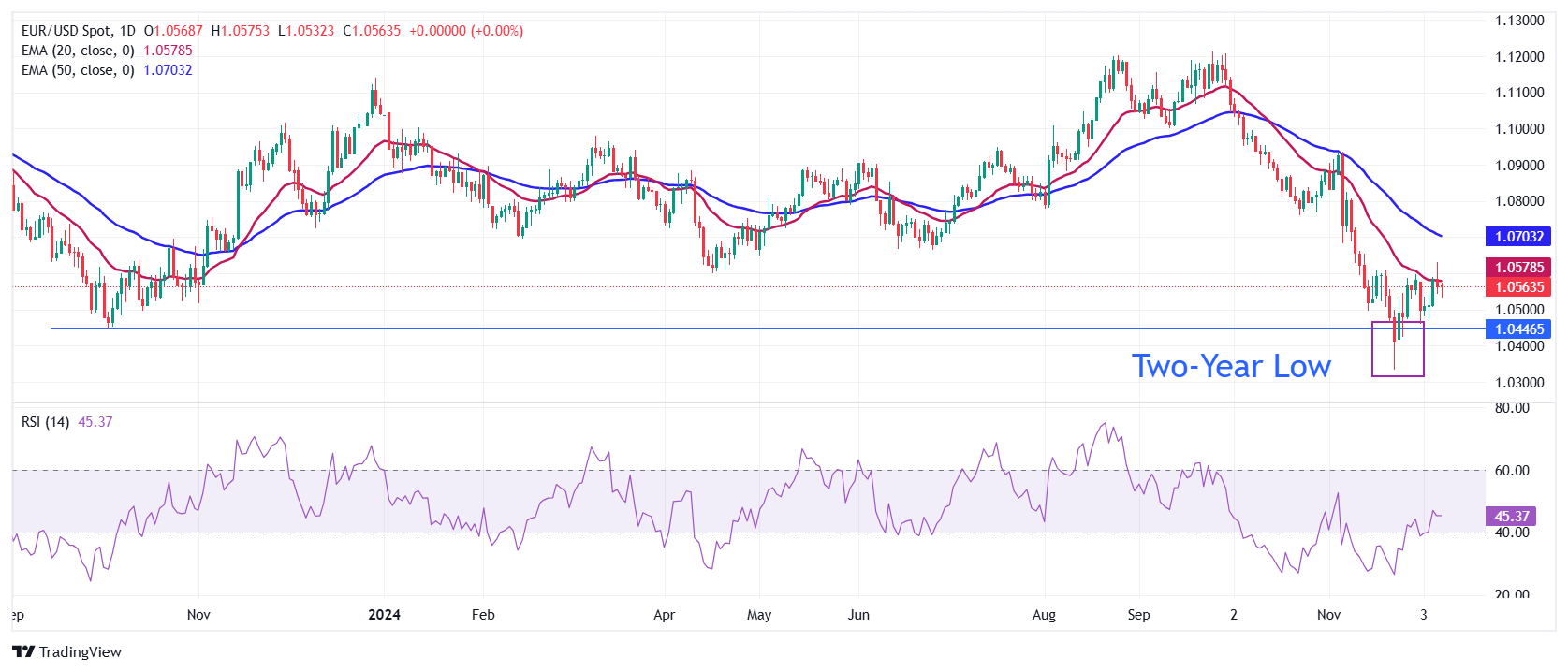- EUR/USD rises to near 1.0580 as investors await US CPI data for November and the ECB policy meeting.
- Investors expect the ECB to cut interest rates by 25 bps for the third time in a row.
- Fed Goolsbee forecasts the central bank to reach the neutral rate by the end of 2025.
EUR/USD gains to near 1.0580 in Monday’s North American session, with investors focusing on the European Central Bank (ECB) monetary policy decision on Thursday. Markets are almost fully pricing in that the ECB will cut its Deposit Facility Rate by 25 basis points (bps) to 3% as many officials have shown concerns over risks of inflation undershooting the bank’s target due to the weak economic outlook.
The ECB has already reduced the deposit rate by 75 bps this year and Thursday’s rate-cut decision would be the third in a row.
Market participants expect the Eurozone economy to underperform amid political uncertainty in Germany and France, which are the largest nations of the bloc. The potential impact on the export sector when US President Donald Trump takes the administration at the White House is also a source of concern.
The French economy is going through a tough phase, and the outlook became gloomier after the government was toppled by lawmakers. Last week, Michel Barnier became the shortest-serving French prime minister after losing a no-confidence vote from the Far Right and the Left-Wing parties over his fiscal plans. French President Emmanuel Macron said that he will find a successor for Barnier “in the coming days.”
Daily digest market movers: EUR/USD edges higher amid firm Fed dovish bets
- EUR/USD gains as the US Dollar (USD) struggles amid firm expectations that the Federal Reserve (Fed) will cut its key borrowing rates in its policy meeting on December 18. The US Dollar Index (DXY), which gauges the Greenback’s value against six major currencies, surrenders its gains generated in the Asian session and struggles to hold the key support of 106.00.
- According to the CME FedWatch tool, the probability for the Fed to cut interest rates by 25 bps to 4.25%-4.50% on December 18 has increased to 87% from 62% a week ago. Fed dovish bets escalated after the United States (US) Nonfarm Payrolls (NFP) report for November showed higher-than-expected hiring numbers.
- For the longer-term outlook on interest rates, Chicago Fed President Austan Goolsbee said on Friday that expects the central bank to reach the median rate by the end of next year. Goolsbee didn’t provide a specific number for the neutral rate but specified that a level around 3%, which is roughly the median that Fed officials projected as a stopping point at their September meeting, “doesn’t seem crazy.”
- This week, investors will focus on the US Consumer Price Index (CPI) data for November, which will be released on Wednesday. Economists expect the annual headline CPI to have accelerated to 2.7% from the October reading of 2.6%, with the core CPI – which excludes volatile food and energy items – growing steadily by 3.3%.
Technical Analysis: EUR/USD holds key support of 1.0500
EUR/USD wobbles above the psychological figure of 1.0500. The outlook of the major currency pair remains bearish as the 20-day EMA near 1.0580 acts as key resistance for the Euro (EUR) bulls.
The 14-day Relative Strength Index (RSI) rebounded after conditions turned oversold and has climbed above 40.00, suggesting that the bearish momentum has faded. However, the broader bearish trend for the pair doesn’t seem to be over yet.
Looking down, the November 22 low of 1.0330 will be a key support. On the flip side, the 50-day EMA near 1.0700 will be the key barrier for the Euro bulls.
ECB FAQs
The European Central Bank (ECB) in Frankfurt, Germany, is the reserve bank for the Eurozone. The ECB sets interest rates and manages monetary policy for the region. The ECB primary mandate is to maintain price stability, which means keeping inflation at around 2%. Its primary tool for achieving this is by raising or lowering interest rates. Relatively high interest rates will usually result in a stronger Euro and vice versa. The ECB Governing Council makes monetary policy decisions at meetings held eight times a year. Decisions are made by heads of the Eurozone national banks and six permanent members, including the President of the ECB, Christine Lagarde.
In extreme situations, the European Central Bank can enact a policy tool called Quantitative Easing. QE is the process by which the ECB prints Euros and uses them to buy assets – usually government or corporate bonds – from banks and other financial institutions. QE usually results in a weaker Euro. QE is a last resort when simply lowering interest rates is unlikely to achieve the objective of price stability. The ECB used it during the Great Financial Crisis in 2009-11, in 2015 when inflation remained stubbornly low, as well as during the covid pandemic.
Quantitative tightening (QT) is the reverse of QE. It is undertaken after QE when an economic recovery is underway and inflation starts rising. Whilst in QE the European Central Bank (ECB) purchases government and corporate bonds from financial institutions to provide them with liquidity, in QT the ECB stops buying more bonds, and stops reinvesting the principal maturing on the bonds it already holds. It is usually positive (or bullish) for the Euro.
Information on these pages contains forward-looking statements that involve risks and uncertainties. Markets and instruments profiled on this page are for informational purposes only and should not in any way come across as a recommendation to buy or sell in these assets. You should do your own thorough research before making any investment decisions. FXStreet does not in any way guarantee that this information is free from mistakes, errors, or material misstatements. It also does not guarantee that this information is of a timely nature. Investing in Open Markets involves a great deal of risk, including the loss of all or a portion of your investment, as well as emotional distress. All risks, losses and costs associated with investing, including total loss of principal, are your responsibility. The views and opinions expressed in this article are those of the authors and do not necessarily reflect the official policy or position of FXStreet nor its advertisers. The author will not be held responsible for information that is found at the end of links posted on this page.
If not otherwise explicitly mentioned in the body of the article, at the time of writing, the author has no position in any stock mentioned in this article and no business relationship with any company mentioned. The author has not received compensation for writing this article, other than from FXStreet.
FXStreet and the author do not provide personalized recommendations. The author makes no representations as to the accuracy, completeness, or suitability of this information. FXStreet and the author will not be liable for any errors, omissions or any losses, injuries or damages arising from this information and its display or use. Errors and omissions excepted.
The author and FXStreet are not registered investment advisors and nothing in this article is intended to be investment advice.
Recommended content
Editors’ Picks

EUR/USD regains traction above 1.1000 ahead of US CPI release
EUR/USD has found fresh buyers and jumps above 1.1000 in the European session on Thursday. The pair gains on the German coalition deal and Trump's 90-day pause on reciprocal tariffs, which have lifted risk senitment while exacerbating the US Dollar pain ahead of the US CPI data release.

GBP/USD trades firm above 1.2850, US CPI data awaited
GBP/USD sustains the rebound above 1.2850 in European trading hours on Thursday. The British Pound capitalizes on risk appetite, courtesy of Trump's tariff pause, allowing the pair to recover ground. But further upside hinges on the US CPI data and US-Sino trade updates.

Gold price enters hotspot region with new all-time high possible
Gold price is delivering a jaw-breaking performance this Thursday in the early trading session, moving around $3,107 at the time of writing. Since Tuesday morning, the precious metal has rallied nearly 5.00%. The main driver for the rally came from the United States President Donald Trump who announced a 90-day pause to higher tariffs on 56 countries and the European Union, which will now be taxed at the 10% baseline rate.

US CPI data set to reveal March inflation dip as markets weigh impact of Trump’s tariffs
As measured by the CPI, inflation in the US is set to rise at an annual pace of 2.6% in March, down slightly from the 2.8% reported in February. Core CPI inflation, which excludes the volatile food and energy categories, is expected to ease to 3% in the same period from a year earlier

Trump’s tariff pause sparks rally – What comes next?
Markets staged a dramatic reversal Wednesday, led by a 12% surge in the Nasdaq and strong gains across major indices, following President Trump’s unexpected decision to pause tariff escalation for non-retaliating trade partners.

The Best brokers to trade EUR/USD
SPONSORED Discover the top brokers for trading EUR/USD in 2025. Our list features brokers with competitive spreads, fast execution, and powerful platforms. Whether you're a beginner or an expert, find the right partner to navigate the dynamic Forex market.




